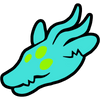DRAGONKIN

Living in the Southern Swamps in hot and humid areas near water. They are a shamanistic group inclined to earth magics.
“ The forest was dense and primal. Its canopy was ruled by willows and glowing-lichen infested mangroves. Little light passed through their crowns, and a melody of reeds and grasses erupted from the shallow, muddy ground. Brambles, vines and decorated talismans dangled down.
A chorus of beastly sounds, crickets and croaking toads, filled the humid and stale air. A set of cracked stone stairs emerged from the mud, surrounded by crumbling ruins with carvings of writing from old.
A low, growling, serpentine voice spoke with a threatening and ancient tone.
“Leave before I swallow you whole, this is your only warning.”
DESCRIPTION
Dragon-Kin that live in arid, dry areas require special lotions made of plants from the swamp areas. They are unable to live in freezing temperature without wearing heavy furs and a constant source of heat.
Dragon-Kin villages tend to be made out of their local materials - trees, plant matter most commonly, and raised above swamp waters on docks and stilts.
Nesting pools, are often created in community areas and clutches of eggs are incubated nearby each other. Eggs are frequently eaten and nesting pools are raided by local wildlife, thus communities who nest together have a higher success rate. New hatchlings live in the pools that they are born in, until they are able to climb out themselves (see Life Cycle).
Dragon-Kin are able to attune to a variety of elements depending on the area they are hatched and raised in. The most common, is earth, water, healing and their magical abilities grow as they age and peaking after death in their Spirit Form. Though not a magical ability, all (Dragon People) are hatched with acidic saliva, which helps them fend off predators and digest meals.
The Dragon-Kin eat primarily fish, though can also eat small game meats, fruits, vegetables and plant matter to supplement their diets. A favoured dish is seared koi, whose scales can be dried and ground into powder that is useful in alchemy.
Common folk attire generally consists of shawls, ponchos, cloaks, and ragged wrappings. Clothing made of moss, seasonal plants and flowers, feathers, furs and natural materials.
Many of the Dragon-Kin are inclined to herbalism, alchemy, natural magics, healers, shamanism, druidism careers and lifestyles.
LIFE CYCLE
eggs 0-3months
Females lay a clutch of 5-8 eggs 1-2 times in their lifetime. usually only 1-2 hatch. eggs incubate in a nest built next to a nursery pond. eggs like heat and moisture and they incubate for several weeks
hatchlings & juveniles 3 months - 6 years
- are blind
- have a “tadpole” tail
- have acidic saliva, and spit it
- live in warm, shallow, calm water pools until they can climb out themselves.
- hunt by spitting their saliva & water at insects, frogs, small lizards, rodents, birds
- after they open their eyes, they will hunt small fish in the pond too.
- they hatch the size of an adult rat,
- they have many predators in the wild due to their size and lack of vision.
- their horns are small and stubby and will grow all throughout their life.
- ears are god for basking in the sun, and listening for prey/predators.
- hatchlings make sounds like frogs, baby crocodiles.
- have webbed feet and hands.
Adolescents 6 years - 20 years
- slowly begins to lose their “tadpole” tail in exchange for fluffy hair
- hands and feet are still webbed
- become more bipedal, but still awkward locomotion.
- about the size of a toddler
- start eating more fish, and learns how to forage.
- accidental uses of small elemental magic start to happen
- like to bask in the sun, eat and play.
- semi aquatic, slowly ventures further from the nursery pool
- third eye opens first
Young adult (21 -74 years)
- learns language, using tools/weaponry
- hunting, gathering, trading and magical studies.
- fully loses any webbing/tadpole tail.
- first become fertile/able to mate
adult 75-299 years
- bipedal 90% of the time
- can use tools, speak any taught language,
- wears clothes for additional warm or fashion,
- but nude is also normal
- hunts larger game with minor elemental magic, weapons
- no webbing on feet/hands
- most of their life is spent at this stage
elder 300-400years
- some hair loss or greying
- age spots on scales are common
- strong elemental magic
- can connect with the spirit realm
- horns continue to grow longer and curled
- Bipedal
young Spirit (0-1,000 years after death)
- this form appears after death
- each individual has their own form, the number of
- limbs and body parts changes.
- loses all hair
- serpentine body
- elemental magical abilities grow
- healing abilities grow
- loses some memories of life
- loses some speech abilities
- can speak through the mind (physic speech)
- translucent
- can float but not fly
- becomes more feral
- prefers to be near area they grew up/hatched.
Ancient spirit (1,000+ years)
- thousands of years past their date of death
- peak of *all* magical abilities
- floating and flying
- considered a lucky symbol
- very rare
- usually guard and protect specific areas of
- a mountain or forest, often an area they grew up or hatched.
- can be difficult to communicate with
- fragmented memory of their life
- the most dangerous, but are docile by nature.
- won’t attack unless provoked/angered
LANGUAGE
Female Names:
Male Names:
Zisot,
Neutral Names:
GALLERY








1 commentaire
Holy fuck, dude.